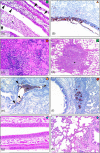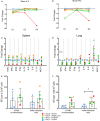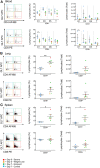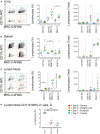The Dynamics of the Ferret Immune Response During H7N9 Influenza Virus Infection
- PMID: 33072098
- PMCID: PMC7541917
- DOI: 10.3389/fimmu.2020.559113
The Dynamics of the Ferret Immune Response During H7N9 Influenza Virus Infection
Abstract
As the recent outbreak of SARS-CoV-2 has highlighted, the threat of a pandemic event from zoonotic viruses, such as the deadly influenza A/H7N9 virus subtype, continues to be a major global health concern. H7N9 virus strains appear to exhibit greater disease severity in mammalian hosts compared to natural avian hosts, though the exact mechanisms underlying this are somewhat unclear. Knowledge of the H7N9 host-pathogen interactions have mainly been constrained to natural sporadic human infections. To elucidate the cellular immune mechanisms associated with disease severity and progression, we used a ferret model to closely resemble disease outcomes in humans following influenza virus infection. Intriguingly, we observed variable disease outcomes when ferrets were inoculated with the A/Anhui/1/2013 (H7N9) strain. We observed relatively reduced antigen-presenting cell activation in lymphoid tissues which may be correlative with increased disease severity. Additionally, depletions in CD8+ T cells were not apparent in sick animals. This study provides further insight into the ways that lymphocytes maturate and traffic in response to H7N9 infection in the ferret model.
Keywords: H7N9; animal model; antigen presenting cells; ferrets; influenza; zoonoses.
Copyright © 2020 Horman, Nguyen, Kedzierska, Butler, Shan, Layton, Bingham, Payne, Bean and Layton.
Figures






Similar articles
-
Mammalian Pathogenesis and Transmission of H7N9 Influenza Viruses from Three Waves, 2013-2015.J Virol. 2016 Apr 14;90(9):4647-4657. doi: 10.1128/JVI.00134-16. Print 2016 May. J Virol. 2016. PMID: 26912620 Free PMC article.
-
H7N9 Influenza Virus Is More Virulent in Ferrets than 2009 Pandemic H1N1 Influenza Virus.Viral Immunol. 2015 Dec;28(10):590-9. doi: 10.1089/vim.2015.0052. Epub 2015 Sep 30. Viral Immunol. 2015. PMID: 26421365
-
Low pathogenic avian influenza A(H7N9) virus causes high mortality in ferrets upon intratracheal challenge: a model to study intervention strategies.Vaccine. 2013 Oct 9;31(43):4995-9. doi: 10.1016/j.vaccine.2013.06.071. Epub 2013 Jun 28. Vaccine. 2013. PMID: 23816392
-
The Pandemic Threat of Emerging H5 and H7 Avian Influenza Viruses.Viruses. 2018 Aug 28;10(9):461. doi: 10.3390/v10090461. Viruses. 2018. PMID: 30154345 Free PMC article. Review.
-
Respiratory Disorders in Ferrets.Vet Clin North Am Exot Anim Pract. 2021 May;24(2):483-493. doi: 10.1016/j.cvex.2021.02.002. Vet Clin North Am Exot Anim Pract. 2021. PMID: 33892896 Review.
References
-
- World Health Organization Influenza at the Human-Animal Interface: Summary and Assessment, 13 February to 9 April 2019. (2019) Available online at: https://www.who.int/influenza/human_animal_interface/Influenza_Summary_I... (accessed May 20, 2020).
-
- Imai M, Watanabe T, Kiso M, Nakajima N, Yamayoshi S, Iwatsuki-Horimoto K, et al. . A highly pathogenic avian H7N9 influenza virus isolated from a human is lethal in some ferrets infected via respiratory droplets. Cell Host Microbe. (2017) 22:615–26.e8. 10.1016/j.chom.2017.09.008 - DOI - PMC - PubMed
Publication types
MeSH terms
LinkOut - more resources
Full Text Sources
Medical
Research Materials
Miscellaneous

